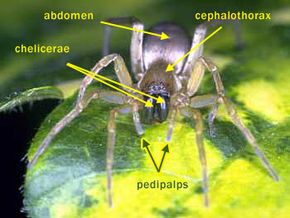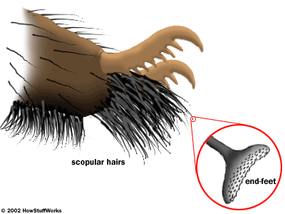Quck answer
Spiders are arachnids that have two body parts, eight legs, and fangs that inject venom into their prey. They use their silk to build webs, catch prey, and protect their eggs. They have several eyes that allow them to detect movement, and some can even see in the dark. Their digestive system is external, and they liquefy their prey with venom before sucking the nutrients out. Spiders molt several times throughout their life, shedding their exoskeleton to grow. Some spiders are venomous to humans, but most are harmless and play an important role in controlling insect populations.
Wild Animals
Parts of the Spider Body

Photo courtesy Ed Nieuwenhuys
Spiders have similar bodily systems to humans, but they function differently and are arranged differently within the body. The cephalothorax contains the brain, stomach, eyes, and mouth, while the abdomen contains the heart, digestive tract, reproductive organs, and lungs.
Spider Respiration
Spiders have two types of respiratory systems, trachea and book lungs. Most species have both, but some have one or the other. These respiratory systems are much simpler than human lungs. Trachea are tubes that run from a slit in the exoskeleton through the body, and air flows in, oxygen diffuses into the blood and carbon dioxide diffuses into the air. A spider’s normal movement provides the necessary energy to push air in and out. Book lungs are thin, leaf-like structures that exchange oxygen and carbon dioxide through diffusion, with blood inside each leaf and air outside.
Spider Blood Circulation
Hemolymph, the spider’s blood, circulates oxygen, nutrients, and hormones to different organs in the body. Spiders have an open circulatory system, and the simple heart pumps blood into the body cavity, where organs soak in the blood to receive oxygen.
Spider Nervous System
Despite having a small brain, spiders can accomplish complex tasks. Their nervous system consists of two ganglia, or nerve cell clusters, connected to nerves leading to the spider’s muscles and sensory systems. The encoded instructions in these nerve cells give spiders the necessary information to undertake complex tasks, such as attacking prey. They can also exhibit learning behavior, abandoning activities that do not work and trying new approaches.

Electron microscope image of one of a spider’s sensitive hairs
Photo courtesy MicroAngela
Spider Senses
Vision is a secondary sense for most spiders. They primarily interact with the world through tactile sensation, with highly sensitive hairs that pick up vibrations in their surroundings. Many spiders also have additional hairs that pick up vibrations in the air and a sense of taste and smell that influence their feeding and reproductive behaviors.
Spider Feet Adaptations
Many spiders have special adaptations that allow them to walk easily on smooth or vertical surfaces. The end of each leg is covered with thick brushes of hair, with tiny microscopic “feet” on each hair that grip the small bumps on whatever surface the spider is walking on, allowing it to move easily over most terrain.

Spiders have dense clusters of hair that have tiny microscopic feet at the end, which allow them to walk on vertical surfaces. Tarantulas are a type of large, hairy spider in the mygalomorphae suborder. Although they may terrify arachnophobes, they are actually harmless to humans. They spend most of their time waiting for prey in the brush or holes and do not spin webs. While they are not venomous to humans, their fangs can puncture the skin and some species can shoot barbed hairs from their back.
FAQ
1. What are spiders?
Spiders are arachnids, which means they are part of the same group as scorpions, ticks, and mites. They have two main body parts, eight legs, and fangs that they use to inject venom into their prey.
2. How do spiders catch their prey?
Spiders use a variety of methods to catch their prey, including spinning webs, ambushing, and actively hunting. Some spiders, like orb weavers, spin intricate webs to catch flying insects, while others, like wolf spiders, chase down their prey on foot.
3. What do spiders eat?
Spiders eat a variety of insects and other small animals like crickets, flies, and even other spiders. Some larger species of spiders, like tarantulas, will even eat small rodents or birds.
4. How do spiders move?
Spiders move by using their legs, which are covered in tiny hairs that allow them to grip onto surfaces. They can walk, climb, and even swim by using their legs to paddle through water.
5. How do spiders reproduce?
Spiders reproduce sexually, with the male transferring sperm to the female using specialized structures called pedipalps. The female will then lay eggs, which she may protect and care for until they hatch.
6. Are spiders dangerous?
While some species of spiders have venom that can be dangerous to humans, most spiders are harmless and even beneficial because they help control insect populations. It is important to be cautious when handling spiders and to seek medical attention if bitten by a venomous species.
7. How long do spiders live?
The lifespan of a spider varies depending on the species, but most live for about a year or two. Some larger species, like tarantulas, can live for up to 20 years in captivity.
8. How do spiders molt?
Spiders molt, or shed their exoskeletons, in order to grow. They will spin a special silk mat to anchor themselves and then wriggle out of their old exoskeleton. After molting, the spider will be soft and vulnerable until its new exoskeleton hardens.





Leave a Reply